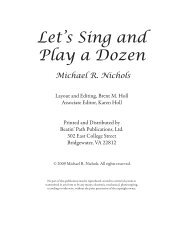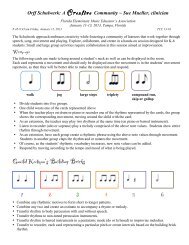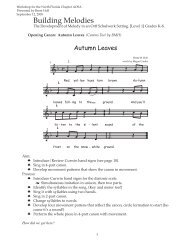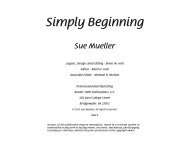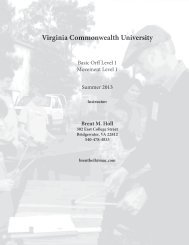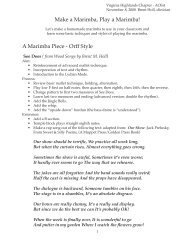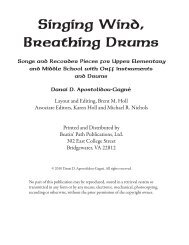Make your own MARIMBAS - Beatin' Path Publications, LLC
Make your own MARIMBAS - Beatin' Path Publications, LLC
Make your own MARIMBAS - Beatin' Path Publications, LLC
You also want an ePaper? Increase the reach of your titles
YUMPU automatically turns print PDFs into web optimized ePapers that Google loves.
<strong>Make</strong> <strong>your</strong> <strong>own</strong> <strong>MARIMBAS</strong><br />
Bass marimba, box resonated 3-player marimba and a minimarimba<br />
• Box resonated 3 1 /2 octave diatonic marimba<br />
• Pipe resonated 3 1 /2 octave diatonic marimba<br />
• Pipe resonated 2 octave bass marimba<br />
• Portable minimarimba<br />
<strong>Make</strong> Your Own Marimbas 1
© COPYRIGHT BY JON MADIN 1996<br />
This edition 2011<br />
All rights reserved<br />
No part of this publication may be reproduced, stored in a retrieval<br />
system or transmitted in any form or by any means, electronic,<br />
mechanical, photocopying, recording or otherwise, without the<br />
prior permission of the copyright <strong>own</strong>er.<br />
ISBN 978-0-9585839-4-7<br />
ACKNOWLEDGEMENTS<br />
For ideas and encouragement:<br />
• Andy Rigby<br />
• Tim Rankin<br />
• Frank Jones<br />
• Caroline Munday<br />
• Phil Melgaard<br />
• Sue Buchan<br />
• Luke Price<br />
For artwork and photographs:<br />
• Julian Cornish<br />
• Caroline Munday<br />
Contact us at www.marimbamusic.com.au<br />
AVAILABILITY<br />
This book, as well as:<br />
'<strong>Make</strong> Your Own Wacky Instruments',<br />
'Marimba Music 1',<br />
'Marimba Music 2',<br />
'Marimba Music for Little Kids' and<br />
'Marimba Songs' are available from:<br />
Beatin’ <strong>Path</strong> <strong>Publications</strong>, <strong>LLC</strong><br />
302 East College Street, Bridgewater, VA 22812.<br />
540-478-4833 • beatinpath@mac.com<br />
www.beatinpathpublications.com<br />
2 <strong>Make</strong> Your Own Marimbas
Contents<br />
6<br />
21<br />
4 The Four Marimba Designs<br />
5 Design Principals<br />
6 Box Resonated 3 1 /2 Octave Marimba for 3 Players<br />
9 Making the Frame<br />
18 Making the Bars<br />
19 Making the Beaters<br />
21 Pipe Resonated 3 1 /2 Octave Marimba<br />
24 Pipe Resonated 2 Octave Bass Marimba<br />
31 Making the Bars<br />
33 Making the Resonators<br />
38 Making the Beaters<br />
39 Overtone Tuning<br />
42 Minimarimba<br />
50 Other Books by Jon Madin<br />
24<br />
42<br />
<strong>Make</strong> Your Own Marimbas 3
Preview Only<br />
The Four Marimba Designs<br />
Please don't copy<br />
A marimba is a xylophone with a wide range<br />
including deep notes equivalent to those of a<br />
bass xylophone.<br />
The diatonic marimbas described here are<br />
derived from instruments that Andy Rigby,<br />
musician and instrument builder, played in<br />
Zimbabwe and Botswana. He passed on the<br />
knowledge he had gained regarding marimba<br />
construction and certain playing styles. We<br />
then began our marimba experiments by<br />
trying to recreate the Zimbabwean-style<br />
instruments.<br />
I then tried some more extensive changes to<br />
the range of the instruments and tried box<br />
and plastic drum resonation. (Orff Schulwerk<br />
xylophones have box resonators.) These<br />
changes helped make the instruments more<br />
suitable for school and community situations<br />
where large numbers of both musicians and<br />
non-musicians want to be involved.<br />
From the original concept I have developed the<br />
four marimba designs described in this book.<br />
Box resonated 3 1 /2 octave marimbas made and played at Bacchus Marsh Primary School<br />
1. Box Resonated 3 1 /2 Octave 3 Player Diatonic Marimba (page 6)<br />
This marimba is especially suitable for school classroom or family use. It is a sturdy instrument with<br />
folding legs and it can be stored in the upright position. It is straightforward to build. This marimba<br />
is approximately 1920mm (6'3") in length allowing 3, 4 or even 5 people to play at the same time.<br />
Sharp and flat notes may be substituted to increase this marimba’s versatility.<br />
2. Pipe Resonated 3 1 /2 Octave 3 Player Diatonic Marimba<br />
(page 21)<br />
This is the same in range and size as (1), but is resonated by P.V.C.<br />
pipe. The pipes are capped and need to be tuned and fitted<br />
exactly to resonate the tone bars. This makes the instrument a<br />
little more difficult to build than the above model. Some people<br />
prefer the sound of tube resonation. Having pipes also means<br />
that it is possible to obtain the distinctive African marimba timbre<br />
(the buzz) by fitting mirlitons (holes with plastic coverings) to the<br />
resonators.<br />
Pipe resonated marimba being played at<br />
Turramurra Bush Camp<br />
4 <strong>Make</strong> Your Own Marimbas
Preview Only<br />
Design Principles<br />
3. Pipe Resonated 2 Octave<br />
2 Player Bass Marimba (page<br />
24)<br />
The deepest note on this<br />
marimba is an octave below the<br />
3-player instruments. The overall<br />
length is slightly shorter than (1)<br />
and (2), and construction is a<br />
little more challenging than<br />
(2) owing to the fitting of pipe<br />
resonators that have bends.<br />
This marimba has optional<br />
adaptors for the pipes which<br />
are necessary when using sharp<br />
and flat tone bars.<br />
4. Box Resonated 13 Note 1<br />
Player Minimarimba (page 42)<br />
This compact instrument is<br />
a fully por table soprano<br />
xylophone. When not being<br />
played the bars and beaters are<br />
stored inside the instrument<br />
and secured by a well fitting lid.<br />
A handle makes it easily carried,<br />
even by a child.<br />
Bass marimba<br />
In designing these instruments I have kept in mind the following<br />
important points.<br />
• Ease of making. You don’t need to be an instrument-maker to make<br />
these marimbas. Basic woodworking skills and hand tools will suffice.<br />
Tuning the bars (and resonators where applicable) is the only step<br />
where the assistance of someone a bit ‘musical’ may be required.<br />
• Accessibility of materials. Most of the wood and hardware you’ll need<br />
is readily available locally. Kiln dried hardwood is great for the bars<br />
so there is no need to import rainforest timbers.<br />
• Playability. The bars are wide, which makes them hard to miss, and<br />
(apart from the minimarimba) having the instrument up on legs makes<br />
it inviting for the players to move with the music.<br />
• Diatonicity. The tone bars are equivalent to the white notes of the<br />
piano. Sharps and flats can be made and substituted just as on the<br />
Orff Schulwerk instruments.<br />
Copyright Jon Madin 1996<br />
A note for teachers<br />
If you are making a marimba or having one made for school use, the box<br />
resonated design is far simpler to make and is sturdier than the pipe resonated<br />
model.<br />
A note for makers<br />
Please don't copy<br />
Minimarimbas made by students at Ocean Grove<br />
Primary School<br />
If you change any of the dimensions of the box resonator, baffle, or ply top<br />
piece the sound of the instrument will be affected.<br />
<strong>Make</strong> Your Own Marimbas 5
Box Resonated 3 1 /2 Octave Marimba for 3 Players<br />
Preview Only<br />
Please don't copy<br />
MATERIALS REQUIRED<br />
Making a box-resonated marimba involves:<br />
• constructing a frame with legs<br />
• adding a box with baffles to resonate the bars<br />
• making and tuning the bars<br />
• making the beaters.<br />
6 <strong>Make</strong> Your Own Marimbas<br />
3 1 /2 Octave box resonated<br />
3-player marimba<br />
Pitch range of the marimbas in this book<br />
Bass 3-Player Minimarimba<br />
Marimba Marimbas (13 notes)<br />
(2 octaves) (3 1 /2 octaves)<br />
❏<br />
❏<br />
❏<br />
❏<br />
KILN-DRIED HARDWOOD<br />
• 9 metres 65 or 67 x 19mm (decking size).<br />
• 4 metres 55 or 56 x 19mm.<br />
(This can be ripped d<strong>own</strong> from the wider size).<br />
Other timbers such as Merbau, Batu, Kempas, are suitable also. They<br />
are rainforest species, as is the rosewood used for orchestral marimbas.<br />
Softwoods such as pine will make music but they are much more likely<br />
to go out of tune.<br />
IMPORTANT: When buying this timber, make sure it is free of cracks,<br />
splits, large knots, prominent saplines or warping.<br />
PINE<br />
• 2 x 2 metre lengths for long sides. 35 x 70mm.<br />
• 1 metre for the ends. 35 x 70mm also.<br />
• 6 metres 35 x 40 (approx) for the legs.<br />
• 3 metres 42 x 19mm for rungs and box.<br />
PLY<br />
• A sheet of 7mm ply approx 600 x 1200mm for the sides, and<br />
another piece 600 x 800 for the end and partitions. Thinner ply<br />
is not suitable.<br />
• A piece of 12mm ply, chipboard or craftwood 300 x 1300mm for<br />
the floor of the box.<br />
DOWEL<br />
• 22mm hardwood dowel – 600mm for 2 bass beaters.<br />
• 19mm hardwood dowel – 600mm for 2 middle beaters.<br />
• 12mm hardwood dowel – 1200mm for 4 treble beaters.
Preview Only<br />
1. Cut out the long sides and ends of the frame from the 35 x 70 pine.<br />
For lengths and angles see Diagram 1.<br />
Please don't copy<br />
Glue first, then use one central nail to locate the ends correctly onto<br />
the long sides. After drilling, insert 2 coach screws into each corner.<br />
(Photo 1).<br />
2. Cut out the legs from 35 x 40mm pine, then the 4 stoppers from the<br />
same size timber. (Diagram 2)<br />
3. Drill a 5 /16" hole through both the leg and frame 420mm from the<br />
end of the frame. (See photo 2).<br />
Photo 13: The ‘small end’ box in situ.<br />
Photo 12: Lifting the ‘small end’ box into place.<br />
Photo 14: Tightening the screw eyes.<br />
<strong>Make</strong> Your Own Marimbas 7
Preview Only<br />
Pipe Resonated 3 1 /2 Octave Marimba<br />
Making the Bars<br />
Please don't copy<br />
1. From 67 x 19 kiln-dried hardwood cut out the lengths as sh<strong>own</strong> in<br />
the table below. The 2 /9th points are the nodes, at which the bars can<br />
be suspended.<br />
2. If you want to round off the upper edges of the bars with a router,<br />
do that first.<br />
3. Drill one 9 /32" (7mm) hole at the 2 /9th point of each bar. <strong>Make</strong> sure the<br />
hole is centrally located. Drill larger holes if plastic tubing has been<br />
fitted over the nails.<br />
4. Mark each bar with the section to be chiselled out. (Diagram 8). The<br />
chiselled section should be a little over 1 /3 of the total length of the<br />
bar. <strong>Make</strong> sure the chiselled area doesn’t reach the hole or the 2 /9th<br />
point at the other end.<br />
5. Halfway along the underside of the bar, use a tenon saw to make a<br />
horizontal saw cut. For the longer bars this cut can be up to 6mm<br />
deep. For notes in the middle range, make the cut no more than 3mm<br />
deep. For the narrow bars make the sawcut about 2mm deep and<br />
for the 4 highest notes make no sawcut until you have checked the<br />
pitch of the bar.<br />
6. To check the pitch of a bar, hold it vertically between the thumb and<br />
forefinger at the node. Strike it repeatedly with the appropriate size<br />
beater as close as possible to the chromatic tuner (Diagram 9).<br />
7. If the pitch is still well above that required, the saw cut can be<br />
8 <strong>Make</strong> Your Own Marimbas
Preview Only<br />
Pipe Resonated 2 Octave Bass Marimba<br />
Please don't copy<br />
This marimba extends d<strong>own</strong> into the contrabass region. Its range is 2<br />
octaves with a lowest note of C (64Hz). It is diatonic, but by using the<br />
adaptors described, sharps and flats can be substituted.<br />
Many modifications have been made over the past few years in an attempt<br />
to make the instrument practical for playing in schools and performing<br />
groups. These include:<br />
1. Adaptors for the resonating pipes to enable them to resonate notes<br />
a semitone lower.<br />
2. Mounting the resonators in 2 modules for portability.<br />
3. Using thinner hardwood for the tone bars.<br />
4. Extending the range to 2 octaves so that 2 players have all the notes<br />
they require or for 1 player to be more flexible.<br />
5. Adjustable buzzers to provide varying amounts of ‘buzz’ – the timbre<br />
associated with African marimbas. (Not recommended for primary<br />
school instruments.)<br />
Far left:<br />
Jon Madin playing the<br />
bass marimba<br />
described in this book.<br />
Left:<br />
Students at Christ Church<br />
Grammar School, Perth<br />
play on a bass marimba,<br />
a 3-player marimba and<br />
xylophones.<br />
<strong>Make</strong> Your Own Marimbas 9
Minimarimba<br />
Preview Only<br />
Acting on a suggestion from teachers at the Ocean Grove Primary<br />
School, I designed a small portable xylophone similar in size and range<br />
to commercially available instruments, but one that could be built by<br />
students with some adult help, that had a satisfying tone and was fully<br />
portable. The bars and beaters can fit inside and are enclosed by a lid.<br />
An alternative name might be the Can Can Minimarimba. In the key of C<br />
the range of the famous tune fits this instrument exactly!<br />
Please don't copy<br />
All materials for this instrument should be available from local wood,<br />
hardware and camping shops. If you are planning to make multiple<br />
instruments, templates of the sides, ends etc. might be useful for the<br />
students to copy.<br />
Tuning the tone bars is the biggest job. Using a power tool to remove<br />
some of the wood from the underside of bars may help, leaving students<br />
to chisel or rasp the final amount needed to tune the instrument<br />
correctly.<br />
N.B. Instructions for bar-tuning are located in the 3-player marimba section<br />
on page 16, but be sure to use the bar lengths for this minimarimba as<br />
detailed on page 47.<br />
Minimarimbas made by the children at Ocean Grove Primary School.<br />
The pitch range is sh<strong>own</strong> on Page 4.<br />
10 <strong>Make</strong> Your Own Marimbas
Other Books by Jon Madin<br />
Marimba Music for Little Kids<br />
is a collection of songs with simple tuned percussion parts<br />
associated with them. For the youngest children - 5-6 year olds<br />
- the songs involve lots of actions and only a few specific notes.<br />
<strong>Make</strong> <strong>your</strong> Own Wacky Instruments<br />
Illustrated instructions for making homemade musical<br />
instruments for Schools, parades and just for fun. The designs<br />
range from rubber glove hooters to blue barrel drums. Many of<br />
the instruments are suitable for classroom construction, while<br />
other require a more technical approach.<br />
Books and CDs available from:<br />
Beatin’ <strong>Path</strong> <strong>Publications</strong>, <strong>LLC</strong><br />
302 East College Street, Bridgewater, VA 22812.<br />
540-478-4833 • beatinpath@mac.com<br />
www.beatinpathpublications.com<br />
Marimba Music 1 (book and CD)<br />
Simple arrangement for diatonic marimbas, xylophones and<br />
other instruments. The pieces are designed to include easy and<br />
more challenging parts to suit multi level classes. Children can<br />
progress to harder parts and harder pieces. The accompany CD is<br />
instrumental only.<br />
Marimba Music 2 (book and CD)<br />
This is similar to Marimba Music 1, except that the pieces are<br />
pitched at a slightly higher level. They are suitable for upper<br />
primary and Junior high school classes. This book includes a<br />
marimba arrangement of the 'Heel Toe' melody, a simple 12-bar<br />
song and tunes inspired by Indonesian, African and Reggae music.<br />
Marimba Songs<br />
This is a collection of songs for children with easy<br />
arrangements for marimbas and xylophones. It is designed<br />
mainly for middle and upper primary school children.<br />
<strong>Make</strong> Your Own Marimbas 11
Beatin’ <strong>Path</strong> <strong>Publications</strong>, <strong>LLC</strong><br />
Music That Works!<br />
More music for marimbas grades 4 - 8 from Beatin’ <strong>Path</strong> <strong>Publications</strong>:<br />
Wood Songs - Book/CD (Easy and Intermediate pieces for Xylophones and Marimbas)<br />
Brent M. Holl $19.95<br />
Cooking With Marimbas - Book/CD (Easy to Intermediate Pieces for Marimbas or Orff Instruments) $24.95<br />
High Sticking - Book (Easy and Intermediate Pieces for Marimbas or Orff Instruments) $19.95<br />
Scott Tarantino and David L. Ruggiero<br />
Wooden Voices Vol. 2 - Book (Twelve Original Works for Marimba Ensemble Beginning to Intermediate) $19.95<br />
Eric Schopmeyer and Adrienne Leverette<br />
More music for grades 4 - 8 from <strong>Beatin'</strong> <strong>Path</strong> <strong>Publications</strong>:<br />
Here's Two - Book/CD (A Jazz Collection for the Orff Classroom) $19.95<br />
Patrick Ware<br />
Canya Conga? (Conga Drum Activities) $19.95<br />
Chris Judah-Lauder<br />
Singing Wind, Breathing Drum - Book (Songs and Recorder Pieces with Drums and Orff Instruments) $14.95<br />
Danai D. Apostolidou-Gagné<br />
Ensemble - Book/CD (Easy and Intermediate pieces for Orff Ensemble) $19.95<br />
Brent M. Holl<br />
All editions are available from Beatin’ <strong>Path</strong> <strong>Publications</strong>, <strong>LLC</strong><br />
302 East College Street, Bridgewater, VA 22812.<br />
540-478-4833 • beatinpath@mac.com<br />
www.beatinpathpublications.com





